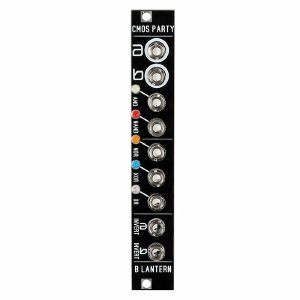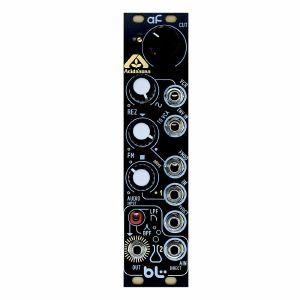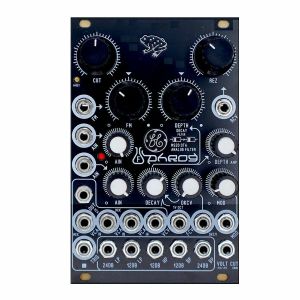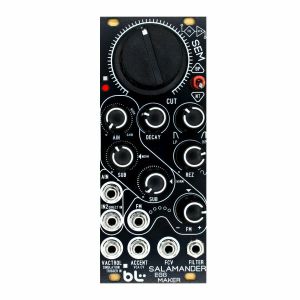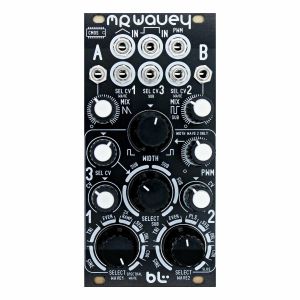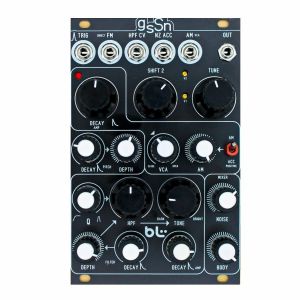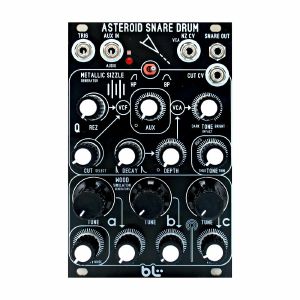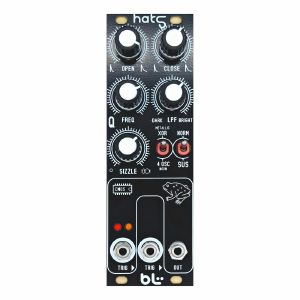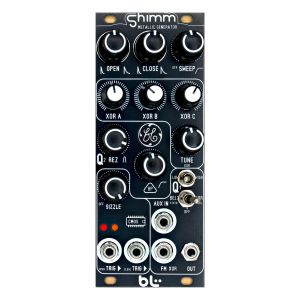Filter
Coming Soon
Equipment
Format
Featured
Price
Tags
Items 1 to 9 of 9 on page 1 of 1
Notes: The CMOS Party Logic, by Blue Lantern, is a readily patchable boolean logic module just waiting for a square wave or clock signal into its corresponding A and B inputs in order to generate a variety of output signals. The module's AND, NAND, NOR, XOR, and OR outputs ensure a variety of potential combinations.
Additionally, the CMOS Party Logic features extremely low latency and is capable of operating at audio rate.
… Read moreAdditionally, the CMOS Party Logic features extremely low latency and is capable of operating at audio rate.
1 in stock $89.61
Click for better price!
or call +44 20 7424 1960
quote 775755
quote 775755
Blue Lantern Modules Acid N Sons 3109-Based Filter Module (filter synth module)
Cat: 920150 Rel: 23 Jan 23
3109-based filter module.
Notes: BLM Acid n Sons Filter
3109-Based Filter
24DB VCF + VCA
This module has the modern 3109 filter chip. The older 3109 chip is found in the vintage Roland keyboards like SH-101. What I did is add resonance audio drop out compensation and precision resistors for the exponential converter. The module will easily track 5+ octaves when in full self oscillation. Band pass was also added as a bonus. The band pass steals the show, as many have not heard an SH-101 with band pass.
-24db low pass
-18db band pass
-Internal VCA for easy voice building
-FM Bi Polar CV input for the Filter
-Envelope Input for the VCA
-Dual Audio Inputs, one direct, and the other with over drive.
Width: 6HP
Current: +64mA -64mA
… Read more3109-Based Filter
24DB VCF + VCA
This module has the modern 3109 filter chip. The older 3109 chip is found in the vintage Roland keyboards like SH-101. What I did is add resonance audio drop out compensation and precision resistors for the exponential converter. The module will easily track 5+ octaves when in full self oscillation. Band pass was also added as a bonus. The band pass steals the show, as many have not heard an SH-101 with band pass.
-24db low pass
-18db band pass
-Internal VCA for easy voice building
-FM Bi Polar CV input for the Filter
-Envelope Input for the VCA
-Dual Audio Inputs, one direct, and the other with over drive.
Width: 6HP
Current: +64mA -64mA
1 in stock $143.83
Click for better price!
or call +44 20 7424 1960
quote 920150
quote 920150
Blue Lantern Modules Phrog Analogue Filter Module (filter synth module)
Cat: 1071520 Rel: 06 Mar 25
An analogue filter with a separate 3 channel mono mixer, and VCA combo
Notes: What does this do?
This is an analogue filter with a separate 3 channel mono mixer, and VCA combo. There is also an internal envelope generator with Decay. All this product needs is a VCO and a trigger signal to complete a mini voice.
The outputs on the filter are meant to be manually patched into one of the VCA audio inputs on the module to complete the mini voice. You can mix and match to create custom filter types.
The Feedback on the product 'Rez', is what makes this sound like an MS20 filter. There are diodes, used as a limiter, and also to wave shape when in self oscillation mode.
Features:
-2 audio inputs with 2 level control knobs.
-Bi-polar FM for the filter.
-Mod input with level knob for the filter.
-FCV Filter CV direct input for the filter.
All CV inputs for the Filter are 1V per octave, Exponential.
-REZ CV
-VOLT CUT output. +5v/5v output. Used to remote control another filter, with the master 'Cut' knob.
-Internal Envelope Generator, with Level Sends to VCA and Filter.
-Separate VCA circuit, with 3 channel mono mixer input.
-1 CV input for the VCA. 'VCV'.
-1 VCA output.
The filter will self oscillate into a sine wave and does track 1v per octave.
Width: 16HP
Current: +65mA,-65mA
PCB Stack: 1 Level, Skiff compatible.
… Read moreThis is an analogue filter with a separate 3 channel mono mixer, and VCA combo. There is also an internal envelope generator with Decay. All this product needs is a VCO and a trigger signal to complete a mini voice.
The outputs on the filter are meant to be manually patched into one of the VCA audio inputs on the module to complete the mini voice. You can mix and match to create custom filter types.
The Feedback on the product 'Rez', is what makes this sound like an MS20 filter. There are diodes, used as a limiter, and also to wave shape when in self oscillation mode.
Features:
-2 audio inputs with 2 level control knobs.
-Bi-polar FM for the filter.
-Mod input with level knob for the filter.
-FCV Filter CV direct input for the filter.
All CV inputs for the Filter are 1V per octave, Exponential.
-REZ CV
-VOLT CUT output. +5v/5v output. Used to remote control another filter, with the master 'Cut' knob.
-Internal Envelope Generator, with Level Sends to VCA and Filter.
-Separate VCA circuit, with 3 channel mono mixer input.
-1 CV input for the VCA. 'VCV'.
-1 VCA output.
The filter will self oscillate into a sine wave and does track 1v per octave.
Width: 16HP
Current: +65mA,-65mA
PCB Stack: 1 Level, Skiff compatible.
1 in stock $260.00
Click for better price!
or call +44 20 7424 1960
quote 1071520
quote 1071520
Blue Lantern Modules SEM VCF Analogue Filter Module (modular synthesiser)
Cat: 1023506 Rel: 18 Jun 24
Analogue 1974 SEM filter module - 10HP
Notes: What does this do?
This is an analogue filter based on the 1974 SEM filter. The original early design did not self oscillate into a sine wave. This one also does not self oscillate. The sound, however, makes up for that. You get the original notch sweep, and incredible band pass mode at such a low friendly price.
Added Features
-Onboard VCA
-Onboard envelope generator (decay)
-Variable trigger input circuit. Emulates a Vactrol.
-Dual audio input possible
Width: 10HP
Depth: 1 PCB stack, skiff compatible
… Read moreThis is an analogue filter based on the 1974 SEM filter. The original early design did not self oscillate into a sine wave. This one also does not self oscillate. The sound, however, makes up for that. You get the original notch sweep, and incredible band pass mode at such a low friendly price.
Added Features
-Onboard VCA
-Onboard envelope generator (decay)
-Variable trigger input circuit. Emulates a Vactrol.
-Dual audio input possible
Width: 10HP
Depth: 1 PCB stack, skiff compatible
2 in stock $131.39
Click for better price!
or call +44 20 7424 1960
quote 1023506
quote 1023506
Blue Lantern Modules Mr Wavey Wave Shaper Module (modular synthesiser)
Cat: 1023511 Rel: 18 Jun 24
Wave shaper module
Notes: What does this do?
This module takes two external sources (patched) from an external other module. It wants a triangle waveform and a square waveform.
The internal analogue circuitry will make you a variety of wave forms, selectable by knob. You can also blend the output with a slicer and a sub harmonic generator on the second channel.
This moduleis a considerable upgrade from a typical VCO. The wave shapes found on this product is the result of using going 15+ years' worth of analogue circuits.
You get two channels of waveform banks. Each can output something separate and different.
There is CV control for the Waveform selection banks, Sub harmonic selection bank, and Pulse Wave Modulation on channel 2.
Does this module require another module?
Yes, you need an oscillator VCO module. Best compatibility is a VCO with triangle wave and square wave.
Self oscillating sine wave from a VCF module can be used but will not take full advantage of the module.
Stack: 2 Level PCB sand which
Caution, not skiff friendly. Compatible with POD cases by 4MS
Width: 12hp
Current: +115mA -110mA
… Read moreThis module takes two external sources (patched) from an external other module. It wants a triangle waveform and a square waveform.
The internal analogue circuitry will make you a variety of wave forms, selectable by knob. You can also blend the output with a slicer and a sub harmonic generator on the second channel.
This moduleis a considerable upgrade from a typical VCO. The wave shapes found on this product is the result of using going 15+ years' worth of analogue circuits.
You get two channels of waveform banks. Each can output something separate and different.
There is CV control for the Waveform selection banks, Sub harmonic selection bank, and Pulse Wave Modulation on channel 2.
Does this module require another module?
Yes, you need an oscillator VCO module. Best compatibility is a VCO with triangle wave and square wave.
Self oscillating sine wave from a VCF module can be used but will not take full advantage of the module.
Stack: 2 Level PCB sand which
Caution, not skiff friendly. Compatible with POD cases by 4MS
Width: 12hp
Current: +115mA -110mA
1 in stock $167.06
Click for better price!
or call +44 20 7424 1960
quote 1023511
quote 1023511
Blue Lantern Modules Gimme Some Snare Drum Analogue Snare Drum Module (drum synth module)
Cat: 969332 Rel: 13 Nov 23
Analogue voice snare drum module - 16HP.
Notes: What does this do?
This is a mini analogue synthesizer that produces snare drum sounds. Inspiration was taken from the 5U Cor Synth DR02 module. Only the flow chart was studied and used to create this BLM product. VCV Rack was also used to simulate and test the building blocks.
Most of the circuits contained in this product are from other blue lantern module designs.
Some of the building blocks:
-2 1V/Octave Triangle Core VCO's
-2 Sine Wave Shapers
-4 Envelope Generator
-White Noise Generator
-High Pass Filter
-Tone Filter
-2 VCA's
-Mixer
The goal of this module was to recreate some of the more exotic electronic snare sounds.
You're not getting another Roland 'TR' module with the Gimme Some Snare Drum. All the building blocks contain full analogue circuitry, like OTA chips, and Op-amps. No vintage transistor based (Bridge T Oscillator) circuits are used in this product.
The best description as to what the kind of snare drum sounds this module can produce is something comparable to:
an Electribe Korg ER-1, Simmons Snare Drum, and the Mattel Synsonics.
Dimensions
16 HP
32 mm deep
Current Draw
107 mA +12V
97 mA -12V
… Read moreThis is a mini analogue synthesizer that produces snare drum sounds. Inspiration was taken from the 5U Cor Synth DR02 module. Only the flow chart was studied and used to create this BLM product. VCV Rack was also used to simulate and test the building blocks.
Most of the circuits contained in this product are from other blue lantern module designs.
Some of the building blocks:
-2 1V/Octave Triangle Core VCO's
-2 Sine Wave Shapers
-4 Envelope Generator
-White Noise Generator
-High Pass Filter
-Tone Filter
-2 VCA's
-Mixer
The goal of this module was to recreate some of the more exotic electronic snare sounds.
You're not getting another Roland 'TR' module with the Gimme Some Snare Drum. All the building blocks contain full analogue circuitry, like OTA chips, and Op-amps. No vintage transistor based (Bridge T Oscillator) circuits are used in this product.
The best description as to what the kind of snare drum sounds this module can produce is something comparable to:
an Electribe Korg ER-1, Simmons Snare Drum, and the Mattel Synsonics.
Dimensions
16 HP
32 mm deep
Current Draw
107 mA +12V
97 mA -12V
1 in stock $273.28
Click for better price!
or call +44 20 7424 1960
quote 969332
quote 969332
Blue Lantern Modules Asteroid Snare Drum MK2 TR-606 Inspired Snare Drum Module (drum synth module)
Cat: 976376 Rel: 13 Nov 23
TR-606 inspired snare drum module - 16HP
Notes: What does this do?
This is a sound generator module with 3 oscillators + noise generator. This module is a complete mini synthesizer that can easily produce snare drum sounds. A 'trigger' signal is patched in order to hit the snare drum. The bottom row contains an internal mixer where you mix in 2 shell generator oscillators, one thud oscillator, and a noise generator.
The Trigger input is level sensitive. Lower voltages will result in quiet snare sounds. You can use this to simulate accent.
The Filter on the 'Impact' signal path was carefully designed just for snare drum tone control. It sounds very nice. It will not self oscillate, but the Q control can go very high in frequency. It has a 12db High pass Filter and a 12db Band Pass Filter. There is CV control for the cutoff and CV control for the internal VCA.
An auxilary audio input has been added to the filter. You can mix external sounds.
The tone of this module is very hollow. It simulates wood like snare sounds.
What this module can not do:
-FM modulation of the internal vco's
-track 1V per octave
-increase the decay legnth of the vco's. 808 like.
This module will always remain in snare land. You can not make it sound like a lead synth. This is a good thing. No menu diving, and the snare is always ready.
History of the design:
The Asteroid Snare drum started out on bread board as a TR 606 snare drum. That design only contains one oscillator, a transistor based noise generator, and a 'clipper' brute vca. It is a nice efficient old design, but it is too simple and boring. I decided to add (2) of the original oscillators, and replaced the noise generator with a digital based noise generator to make sure all production units were alike. The snare drum still was missing fullness, so I designed an addition oscillator called 'thud'. The poor vca from the original design was removing all the additional harmonics, so that was replaced by a OTA based vca, and I added tonal controls to the IMPACT signal, and the THUD signal path.
A 12db analogue filter was recently added in the singal path of the Impact circuit. Audio input was also added, with a static internal HPF on this input. The Aux input will sound metal like by default.
All of this amounts to about 200+ smt parts. Far exceeding the original design.
Dimensions
16 HP
32 mm deep
Current Draw
48 mA +12V
45 mA -12V
… Read moreThis is a sound generator module with 3 oscillators + noise generator. This module is a complete mini synthesizer that can easily produce snare drum sounds. A 'trigger' signal is patched in order to hit the snare drum. The bottom row contains an internal mixer where you mix in 2 shell generator oscillators, one thud oscillator, and a noise generator.
The Trigger input is level sensitive. Lower voltages will result in quiet snare sounds. You can use this to simulate accent.
The Filter on the 'Impact' signal path was carefully designed just for snare drum tone control. It sounds very nice. It will not self oscillate, but the Q control can go very high in frequency. It has a 12db High pass Filter and a 12db Band Pass Filter. There is CV control for the cutoff and CV control for the internal VCA.
An auxilary audio input has been added to the filter. You can mix external sounds.
The tone of this module is very hollow. It simulates wood like snare sounds.
What this module can not do:
-FM modulation of the internal vco's
-track 1V per octave
-increase the decay legnth of the vco's. 808 like.
This module will always remain in snare land. You can not make it sound like a lead synth. This is a good thing. No menu diving, and the snare is always ready.
History of the design:
The Asteroid Snare drum started out on bread board as a TR 606 snare drum. That design only contains one oscillator, a transistor based noise generator, and a 'clipper' brute vca. It is a nice efficient old design, but it is too simple and boring. I decided to add (2) of the original oscillators, and replaced the noise generator with a digital based noise generator to make sure all production units were alike. The snare drum still was missing fullness, so I designed an addition oscillator called 'thud'. The poor vca from the original design was removing all the additional harmonics, so that was replaced by a OTA based vca, and I added tonal controls to the IMPACT signal, and the THUD signal path.
A 12db analogue filter was recently added in the singal path of the Impact circuit. Audio input was also added, with a static internal HPF on this input. The Aux input will sound metal like by default.
All of this amounts to about 200+ smt parts. Far exceeding the original design.
Dimensions
16 HP
32 mm deep
Current Draw
48 mA +12V
45 mA -12V
1 in stock $205.79
Click for better price!
or call +44 20 7424 1960
quote 976376
quote 976376
Blue Lantern Modules Hats Analogue High Hats Module (drum/oscillator module)
Cat: 980377 Rel: 18 Jun 24
Analogue hi-hats module - 8HP
Notes: This is a self contained analogue high hat module. This is a Transistor based VCA design. It is influenced by the DR110 drum machine. The original circuit used 4 oscillators to make the metallic audio sound. I added the original 4 oscillator, and an extra 6 oscillator circuit. The 6 oscillator version is doing a double XOR ringmod (internally). You select that by switch.
The 4 oscillator design sounds more crunchy, where as the 6 XOR circuit sounds more polished with sheen. You can blend in the amount of white noise in the mix labeled 'sizzle'.
Internally, the audio is passing through a few high pass filters, making the output sound very high in frequencies.
The module by itself is not exciting. But in the mix, with other percussion modules, this is your favorite-go-to module. It sits almost perfect in the mix.
There are two triggers. One is for 'Open' sound. The other is for 'close' sound. Both open and close have there own decay knob to adjust the length of the audio tail.
There is a tone control, labeled LPF. Use this to taper off some of the high frequencies.
Instead of adding an 'accent' control. Both triggers have been made to voltage variable. 5V triggering is the normal expected input. So a 3V trigger will sound softer in volume. 10V trigger signals will sound louder.
This module is as simple as it gets, just patch your Arturia Beat Step Pro and use the drum track.
Features
-Both trigger inputs are voltage variable. You can get softer audio, with softer trigger voltage.
-2 voice metallic noise generator
-2 decays (open and close)
-2 Flavors select by switch.
-Normal mode, and Sustain mode, selected by switch.
-frequency adjustment of the internal XOR ringmod.
-classic roland sounding transistor based VCA.
Why get this module over the Shimm module, or other high hats modules?
-Ease of use, ready to go. No sound exploring needed.
-Want the classic transistor based, crunchy sound.
-lower budget
-Sits very well in the drum mix.
Dimensions
8 HP
32 mm deep
Current Draw
21 mA +12V
13 mA -12V
… Read moreThe 4 oscillator design sounds more crunchy, where as the 6 XOR circuit sounds more polished with sheen. You can blend in the amount of white noise in the mix labeled 'sizzle'.
Internally, the audio is passing through a few high pass filters, making the output sound very high in frequencies.
The module by itself is not exciting. But in the mix, with other percussion modules, this is your favorite-go-to module. It sits almost perfect in the mix.
There are two triggers. One is for 'Open' sound. The other is for 'close' sound. Both open and close have there own decay knob to adjust the length of the audio tail.
There is a tone control, labeled LPF. Use this to taper off some of the high frequencies.
Instead of adding an 'accent' control. Both triggers have been made to voltage variable. 5V triggering is the normal expected input. So a 3V trigger will sound softer in volume. 10V trigger signals will sound louder.
This module is as simple as it gets, just patch your Arturia Beat Step Pro and use the drum track.
Features
-Both trigger inputs are voltage variable. You can get softer audio, with softer trigger voltage.
-2 voice metallic noise generator
-2 decays (open and close)
-2 Flavors select by switch.
-Normal mode, and Sustain mode, selected by switch.
-frequency adjustment of the internal XOR ringmod.
-classic roland sounding transistor based VCA.
Why get this module over the Shimm module, or other high hats modules?
-Ease of use, ready to go. No sound exploring needed.
-Want the classic transistor based, crunchy sound.
-lower budget
-Sits very well in the drum mix.
Dimensions
8 HP
32 mm deep
Current Draw
21 mA +12V
13 mA -12V
1 in stock $119.49
Click for better price!
or call +44 20 7424 1960
quote 980377
quote 980377
Blue Lantern Modules Shimm Fully Voiced High Hat Module (drum module)
Cat: 980379 Rel: 18 Jun 24
A metallic shimmer generator that contains all the onboard processing needed to complete a percussive voice
Notes: What does this module do?
This is a sound generator, specifically, a metallic shimmer generator. This module contains all the onboard processing needed to complete a percussive voice. There is a manual XOR shimmer generator, and a static cowbell like generator. You can also turn those two off, and just use the internal white noise (sizzle).
There is an onboard High Pass Filter with two resonant peaks. One is controlled by knob, the other is selected by toggle switch. Labelled Q1 and Q2. An Auxilary input has been added so that you can process sound through the high pass filter.
There is also a Sweep Knob which internally patches the decay to the high pass filter.
A white noise generator is used to blend in with the shimmer generator. Labelled SIZZLE.
There are two triggers. One is for 'Open' sound. The other is for 'close' sound. Both open and close and have their own decay knob to adjust the length of the audio tail.
Instead of adding an 'accent' control. Both triggers have been made to be voltage variable. 5V triggering is the normal expected input. So a 3V trigger will sound softer in volume. 10V trigger signals will sound louder.
This module is as simple as it gets, just patch your Arturia Beat Step Pro and use the drum track.
Width: 10HP
Current: +55mA,-32mA
… Read moreThis is a sound generator, specifically, a metallic shimmer generator. This module contains all the onboard processing needed to complete a percussive voice. There is a manual XOR shimmer generator, and a static cowbell like generator. You can also turn those two off, and just use the internal white noise (sizzle).
There is an onboard High Pass Filter with two resonant peaks. One is controlled by knob, the other is selected by toggle switch. Labelled Q1 and Q2. An Auxilary input has been added so that you can process sound through the high pass filter.
There is also a Sweep Knob which internally patches the decay to the high pass filter.
A white noise generator is used to blend in with the shimmer generator. Labelled SIZZLE.
There are two triggers. One is for 'Open' sound. The other is for 'close' sound. Both open and close and have their own decay knob to adjust the length of the audio tail.
Instead of adding an 'accent' control. Both triggers have been made to be voltage variable. 5V triggering is the normal expected input. So a 3V trigger will sound softer in volume. 10V trigger signals will sound louder.
This module is as simple as it gets, just patch your Arturia Beat Step Pro and use the drum track.
Width: 10HP
Current: +55mA,-32mA
1 in stock $150.47
Click for better price!
or call +44 20 7424 1960
quote 980379
quote 980379
Items 1 to 9 of 9 on page 1 of 1

 USD
USD





